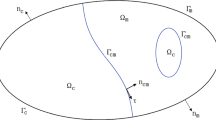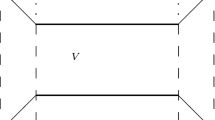Abstract
The effects of discretization on the equations, and their solutions, describing Rayleigh–Bénard convection are studied through linear stability analysis and numerical integration of the discretized equations. Linear stability analyses of the discretized equations were conducted in the usual manner except that the assumed solution contained discretized components (e.g., spatial grid interval in the x direction, \({\Delta x}\)). As the resolution became infinitely high (\({\Delta x \rightarrow 0}\)), the solutions approached those obtained from the continuous equations. The wavenumber of the maximum growth rate increased with increasing \({\Delta x}\) until the wavenumber reached a minimum resolvable resolution, \({\pi \Delta x^{-1}}\). Therefore, the discretization of equations tends to reproduce higher-wavenumber structures than those predicted by the continuous equations. This behavior is counter intuitive and opposed to the expectation of \({\Delta x}\) leading to blurred simulated convection structures. However, when the analysis is conducted for discretized equations that are not combined into a single equation, as is the case for practically solved numerical models, the maximum growing wavenumber rather tends to decrease with increasing \({\Delta x}\) as intuitively expected. The degree of the decrease depends on the discretization accuracy of the first-order differentials. When the accuracy of the discretization scheme is of low order, the wavenumber monotonically decreases with increasing \({\Delta x}\). On the other hand, when higher-order schemes are used for the discretization, the wavenumber does increase with increasing \({\Delta x}\), a similar trend to that in the case of the single-discretized equation for smaller \({\Delta x}\).
Similar content being viewed by others
References
Holton J.R.: An Introduction to Dynamic Meteorology. Academic Press, London (2004)
Mironov, D.V.: Turbulence in the lower troposphere: second-order closure and mass-flux modelling frameworks. In: Hillebrandt, W., Kupka, F. (eds.) Interdisciplinary Aspects of Turbulence. Lecture Notes in Physics, vol. 756, pp. 161–221. Springer (2009)
Miyamoto Y., Kajikawa Y., Yoshida R., Yamaura T., Yashiro H., Tomita H.: Deep moist atmospheric convection in a sub-kilometer global simulation. Geophys. Res. Lett. 40, 4922–4926 (2013)
Bryan G.H., Wyngaard J.C., Fritsch J.M.: Resolution requirements for the simulation of deep moist convection. Mon. Weather Rev. 131, 2394–2416 (2003)
Piotrowski Z.P., Smolarkiewicz P.K., Malinowski S.P., Wyszogrodzki A.A.: On numerical realizability of thermal convection. J. Comput. Phys. 228, 6268–6290 (2009)
Zhou B., Simon J.S., Chow F.K.: The convective boundary layer in the terra incognita. J. Atmos. Sci. 71, 2545–2563 (2014)
Drazin P.G., Reid W.H.: Hydrodynamic Stability. Cambridge University Press, Cambridge (2004)
Grothbach G.: Spatial resolution requirement for direct numerical simulation of Rayleigh–Benard convection. J. Comput. Phys. 49, 241–264 (1983)
Chow F.K., Moin P.: A further study of numerical errors in large-eddy simulations. J. Comput. Phys. 184, 366–380 (2003)
Meyers J., Geurts B.J., Sagaut P.: A computational error-assessment of central finite-volume discretizations in large-eddy simulation using a Smagorinsky model. J. Comput. Phys. 227, 156–173 (2007)
Celik I., Klein M., Freitag M., Janicka J.: Assessment measures for URANS/DES/LES: an overview with applications. J. Turbul. 7, 1–27 (2006)
Sullivan P.P., Patton E.G.: The effect of mesh resolution on convective boundary layer statistics and structures generated by large-eddy simulation. J. Atmos. Sci. 68, 2395–2415 (2011)
Durran D.: Numerical Methods for Wave Equations in Geophysical Fluid Dynamics. Springer, Berlin (1999)
Author information
Authors and Affiliations
Corresponding author
Additional information
Communicated by R. Klein.
Rights and permissions
About this article
Cite this article
Miyamoto, Y., Ito, J., Nishizawa, S. et al. A linear thermal stability analysis of discretized fluid equations. Theor. Comput. Fluid Dyn. 29, 155–169 (2015). https://doi.org/10.1007/s00162-015-0345-x
Received:
Accepted:
Published:
Issue Date:
DOI: https://doi.org/10.1007/s00162-015-0345-x




